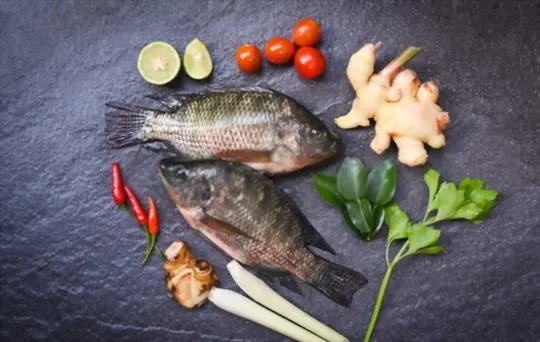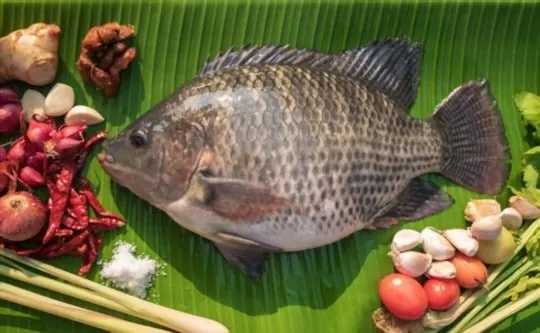Do you encounter various fish fillets in the grocery store and ever feel perplexed, wondering what’s really in that container?
Some may resemble others, but do they taste the same or even have similar health effects?
Two of these fish are swai and tilapia, which have grown more popular as alternatives to seafood.
Ever wondered how they’re different and which one might be a healthier choice for you?
Don’t worry, because this blog post will be exploring their traits compared to each other: from sustainability status to nutrition values!
Read on if you want to learn everything about swai vs tilapia.
Summary of key points
The comparison between Swai and Tilapia highlights several key differences. Swai fish is primarily produced in fish farms in Vietnam, while Tilapia is found worldwide in lakes, rivers, and ponds. Swai fish is known for its slightly sweeter taste and moister texture compared to the slightly nutty flavor and firmer texture of Tilapia. Additionally, Swai is often considered less “fishy” in taste compared to Tilapia. The sources also mention the differences in the production origin and shipping methods of these two types of fish.

What is Swai?

Swai fish is a type of freshwater catfish native to Southeast Asia, particularly found in the Mekong basin and parts of the Chao Phraya river.
It’s known for its mild flavor and firm texture, making it a versatile choice for various culinary methods such as frying, baking, and grilling.
Swai goes by several names, including basa, pangasius, and sometimes inaccurately referred to as “iridescent shark,” despite not being a shark at all.
Nutritionally, swai fish is appreciated for its low mercury content and high protein levels. It is also a good source of essential nutrients like selenium, niacin, and vitamin B12.
These elements are crucial for maintaining a healthy metabolism, supporting immune function, and aiding in red blood cell formation.
However, there has been some controversy surrounding swai fish due to concerns over its farming practices and quality control, especially with imports to countries like the United States.
Issues such as environmental impact, antibiotic use, and adherence to health standards have led to debates about its safety and sustainability.
Despite these concerns, swai remains a popular and affordable seafood option for many consumers.
It’s important for those interested in incorporating swai into their diet to be informed about its origin and how it was raised to make a well-rounded decision regarding its consumption.
What is Tilapia?

Tilapia is a freshwater fish that belongs to the Cichlidae family.
It is one of the most popular and widely farmed fish in the world, particularly in Asia, Africa, and South America.
The fish has a mild taste and firm flesh that makes it popular among consumers.
Tilapia has been cultivated for thousands of years and is now commercially grown all around the globe.
They are easy to breed and grow quickly in various water conditions which make them an attractive option for aquaculture.
When it comes to cooking Tilapia, it is quite versatile.
Its firm flesh can withstand grilling, baking or frying.
Moreover, because of its simplicity in flavor profile, it pairs well with different flavorings like lemon-butter sauce or soy marinade.
Differences Between Swai and Tilapia

When it comes to freshwater fish, Swai and Tilapia are two common types that have been gaining popularity in recent years.
While they may appear similar in some ways, there are several key differences between the two.
Swai comes from Southeast Asia, while Tilapia is found in Africa and Latin America.
The scientific names for Swai and Tilapia are Pangasius hypophthalmus and Oreochromis niloticus respectively.
These two fish also differ in their habitat preferences.
One of the main differences between Swai and Tilapia is their taste and texture.
While both have a mild flavor, Swai has a slightly sweet taste with a moister texture compared to Tilapia’s slightly nutty flavor with a firmer texture.
These distinctions can influence how each fish is prepared and served.
Knowing the differences between these two types of fish can help you make an informed decision when choosing which one to buy or serve at your next meal.
1 – Appearance
When it comes to the appearance of swai and tilapia, there are some noticeable differences.
Swai has a darker skin color than tilapia, which is typically more silver.
Additionally, the scales on swai are larger and more prominent compared to the smaller scales on tilapia.
Swai also tends to have a longer body shape with a flatter head and more pointed nose, while tilapia has a rounder body with a more rounded head.
It’s important to note that appearance alone cannot determine which fish is better or worse.
However, visual differences can be helpful in distinguishing between the two types of fish.
2 – Taste and Texture

Swai and tilapia have some similarities in taste and texture but also some notable differences.
Let’s take a closer look at how the two compare in terms of flavor and mouthfeel.
As you can see from the table above, swai has a milder, sweeter flavor compared to tilapia.
Tilapia, on the other hand, has a mild flavor but with a slightly earthy taste.
In terms of texture, swai is much softer and more delicate than tilapia.
Its flesh flakes easily when cooked and has a tender mouthfeel.
Tilapia has a firmer texture and denser flesh that holds its shape well when cooked.
Both fish are versatile ingredients that can be used in various dishes.
However, given their distinct differences in taste and texture, choosing one over the other will depend on personal preference as well as the specific recipe you are making.
3 – Nutrition Profile
When it comes to choosing between swai and tilapia, the nutrition profile of both fish species should not be overlooked.
Both fish are low in fat, calories and carbohydrates, making them a healthy choice for those looking to maintain or lose weight.
They also contain protein, which is essential for building and repairing tissues in our bodies.
However, there are some differences between the two fish in terms of their nutrient content.
Tilapia has a slightly higher protein content compared to swai, but interestingly enough, swai contains more fat than tilapia.
Swai also contains cholesterol while tilapia does not.
It’s worth noting that both fish species have omega-6 fatty acids but lack omega-3 fatty acids.
This is important because research has linked high levels of omega-6 fatty acids with inflammation and an increased risk of chronic diseases such as heart disease and cancer.
Therefore, it’s recommended to balance your intake of omega-6 and omega-3 fats by consuming other sources of omega-3s like salmon or other types of oily fish.
4 – Farming and Sustainability
When it comes to farming and sustainability, Swai and Tilapia have some significant differences.
While both Swai and Tilapia can be farmed sustainably, the methods used for farming Swai are often less eco-friendly than those used for farming Tilapia.
Swai are often farmed in open ponds or cages with low water quality standards, which can contribute to pollution and other environmental problems.
Additionally, they are typically fed cornmeal or soybean meal, which can have negative environmental impacts if not sourced sustainably.
Tilapia, on the other hand, are generally farmed in closed systems that allow for more precise control over water quality.
They can also be fed a variety of diets, including plant-based feeds that are better for the environment.
Overall, while both Swai and Tilapia can be sustainable choices when it comes to seafood consumption, choosing Tilapia may be a better option for those looking to minimize their environmental impact.
Similarities Between Swai and Tilapia

Swai and tilapia share some similarities in terms of their physical characteristics, nutritional value and taste.
To visually represent the similarities between swai and tilapia, a table can be created with appropriate columns.
Both fish species are white-fleshed, low-fat, and excellent sources of lean protein.
They are also commonly sold in fillets or whole form at grocery stores and markets.
In terms of their nutritional value, both swai and tilapia have high levels of omega-3 fatty acids that are essential for overall health benefits such as reducing inflammation and risk of heart disease.
They are also rich in vitamins B12 and D, which play important roles in maintaining brain function and bone health.
When it comes to taste, both swai and tilapia have a mild flavor with flaky flesh that makes them popular choices among seafood lovers.
Their neutral taste profile allows for versatile cooking methods that highlight their flavors, making them ideal for grilling, baking or frying.
In summary, swai and tilapia share many similarities in terms of their physical characteristics, nutritional value and taste.
These commonalities make them popular choices among consumers seeking affordable and healthy seafood options.
1 – Cooking Methods
When it comes to cooking methods, both swai and tilapia are very versatile.
They can be fried, baked, broiled, grilled, or steamed.
However, it is important to note that each method may produce different results in terms of texture and flavor.
As you can see from the table above, there are no major differences in terms of the cooking methods between swai and tilapia.
Both fish can be cooked in a variety of ways depending on preference.
It’s also worth noting that these fish are very mild in flavor which makes them perfect for experiments with different herbs, spices and sauces.
Whether you’re using fresh parsley or lemon juice or even your own homemade marinade, both swai and tilapia can be used as great canvases for experimenting with flavors without overpowering the taste of the fish itself.
So feel free to explore different ways of cooking these fish.
As long as you keep an eye on them while cooking (as overcooking can result in dryness) they will turn out delicious.
2 – Culinary Versatility
Culinary Versatility is an important aspect when it comes to choosing between swai and tilapia.
Let’s take a closer look at how these two similar fish compare in terms of their versatility in cooking.
As you can see from the table above, both types of fish are relatively mild in flavor but differ slightly in terms of texture.
However, both are quite versatile when it comes to cooking methods.
Swai is particularly good for grilling or frying due to its firm texture that holds up well under high heat.
It can also be baked or broiled with similarly tasty results.
Furthermore, swai is easy to pair with a variety of flavors and marinades.
You can use Swai Fish Taco with Salsa or grilled finger food.
On the other hand, tilapia is also great for grilling or broiling but may be better suited for recipes that require a slightly firmer texture, such as fish tacos or ceviche.
It can also be pan-fried, baked or sautéed in a variety of dishes where the particular nuances of its flavor shine through.
3 – Price and Availability
When it comes to the price and availability of swai and tilapia, there are a few key differences.
Tilapia is often more expensive than swai, and can be more difficult to find in certain areas.
This is largely due to the fact that tilapia is a popular fish for both commercial and recreational fishing, meaning that supply can vary depending on the season and location.
In terms of availability, swai is more commonly found in grocery stores and fish markets across the United States compared to tilapia.
Swai is also generally less expensive than tilapia which makes this fish a popular choice among budget-conscious consumers.
As you can see from the table above, swai tends to be significantly cheaper than tilapia, with prices ranging from $3.99 per pound up to $6.99 per pound depending on where you buy it from.
Tilapia prices can range from $7.99 per pound up to $9.99 per pound.
Overall, if you’re looking for an affordable fish option that’s widely available, swai may be the better choice for you.
However, if you don’t mind spending a bit more money or are looking for a specific flavor profile, tilapia could be worth considering as well.
Which is Better: Swai or Tilapia?

When it comes to deciding which is better between Swai and Tilapia, the answer ultimately depends on personal preference.
However, let’s take a look at some of the factors that may be important in making that decision.
As you can see, both types of fish have their own strengths and weaknesses nutritionally.
While swai has more omega-3 fatty acids, tilapia has fewer calories and more protein per serving.
Another factor to consider when comparing these two types of fish is their taste and texture.
Some people prefer the mild taste of tilapia, while others enjoy the slightly stronger flavor of swai.
Similarly, some people might find swai to be too soft or mushy in texture, while others appreciate its tenderness.
It’s also important to take into account how these fish are farmed or sourced.
Both swai and tilapia are generally raised in aquaculture environments rather than being caught in the wild.
This means that factors like water quality, diet, and farming practices can all impact the final quality of the fish you’re buying.
Ultimately, when deciding between swai and tilapia, it’s up to you to determine what matters most to you personally in terms of taste, nutrition, and sustainability.
Looking at all the factors discussed above can help you make an informed decision, but ultimately the choice between swai and tilapia will depend on your individual preferences.
Conclusion
To sum up, both Swai and Tilapia fish are comparable in terms of nutritional value and taste, but there are some differences in their texture, origin and farming practices.
All in all, choosing between Swai or Tilapia ultimately boils down to personal preference and priorities in terms of taste, environmental impact and nutritional value.
It’s always best to check where your seafood comes from and how it was produced before making a choice.

Swai vs Tilapia: What’s the Difference?
Ingredients
- Swai
- Tilapia
Instructions
- Choose between two items based on your preference and availability.
- Follow the cooking directions for your chosen option, using the appropriate ratio of ingredients.
- Prepare it according to your desired recipes.
- Incorporate them into your dish, adjusting the amount to suit your taste.
- Enjoy the unique taste experience and experiment with different dishes to explore their versatility.

Andrew Gray is a seasoned food writer and blogger with a wealth of experience in the restaurant and catering industries. With a passion for all things delicious, Andrew has honed his culinary expertise through his work as a personal chef and caterer.
His love for food led him to venture into food writing, where he has contributed to various online publications, sharing his knowledge and insights on the culinary world. As the proud owner of AmericasRestaurant.com, Andrew covers a wide range of topics, including recipes, restaurant reviews, product recommendations, and culinary tips.
Through his website, he aims to inspire and educate fellow food enthusiasts, offering a comprehensive resource for all things food-related.

Leave a comment